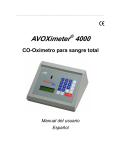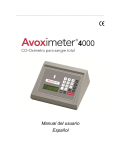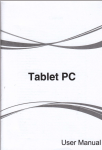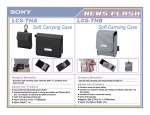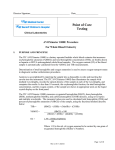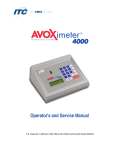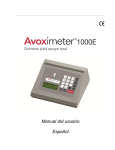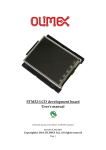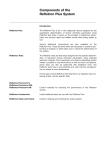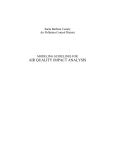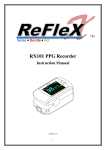Download Compliance Guide for AVOXimeter 1000E
Transcript
AVOXimeter Compliance Guide (Rev 3.98) Contents I. II. Introduction 2 CLIA ‘88 3 Categorization 3 QC Requirements 3 Proficiency Testing 7 III. Oximetry Primer IV. A-VOX QC Program 10 V. Procedures Manual 12 FDA Letter [Complexity Level] 14 Letter from CAP 15 VI. VII. VIII. 8 QC Log Sheets Yellow QC filter (1000 or E) 16 Orange QC filter (1000) 17 Orange QC filter (1000E) 18 IL Multi-4 Level 2 19 IL Multi-4 Level 1 20 RNA CC 527 Level 2 21 AVOXimeter Compliance Guide (Rev3.98) I. INTRODUCTION The AVOXimeter 1000 quickly measures the oxyhemoglobin saturation (%HbO2), the total hemoglobin concentration (THb) and the oxygen content (O2c) of a blood sample in a disposable cuvette. Cardiac catheterization laboratories and intensive care units routinely use such measurements for two purposes: 1) to detect intracardiac and great vessel shunts and 2) to compute cardiac output by the Fick Principle. xl The AVOXimeter has no moving parts and requires almost no maintenance. PRINCIPLE OF MEASUREMENT According to Beer’s Law, if several light-absorbing compounds are present in a solution, the concentration of each compound can be deduced if the compounds differ in their optical absorbances and if optical density is measured at as many wavelengths as there are compounds present. For example, if three compounds X,Y, and Z are present and if the optical density (OD) is measured at three different wavelengths (λ), the result is a set of simultaneous equations with as many equations as there are unknown concentrations (c). Thus if the optical pathlength (l) and the extinction coefficients (e) are known, the concentrations, cx, cy, and cz can be computed from this set of equations: ODλ1 = ex ,λ1cx l + ey ,λ1cy l + ez ,λ1cz l Equation 1 ODλ2 = ex ,λ2cx l + ey ,λ2cy l + ez ,λ2cz l Equation 2 ODλ3 = ex ,λ3cx l + ey ,λ3cy l + ez ,λ3cz l Equation 3 Conventional whole-blood oximeters use only two wavelengths to measure the relative concentrations of two hemoglobin species: oxy- and deoxyhemoglobin. By contrast, the AVOXimeter uses multiple wavelengths to obtain accurate measurements of %HbO2 even if bilirubin and four different hemoglobin species are present in the sample. Thus, for the AVOXimeter, the value reported on the display for %HbO2 is defined as: %HbO2 = [HbO2] / ([Hb] + [HbO2] + [HbCO] + [HbMet]) Equation 4 Similarly, the AVOXimeter reports a value for the total hemoglobin concentration that is the sum of the concentrations of oxy-, deoxy-, met-, and carboxyhemoglobin: [THb] = [HbO2] + [Hb]+ [MetHb] + [HbCO] Equation 5 To overcome the light scattering that red blood cells cause, the AVOXimeter makes an assessment of the amount of light scattering in each sample, employs proprietary optics and mathematical algorithms (patent pending) to correct its measurements for light scattering, and thus obtains an accurate measurement of both oxyhemoglobin saturation and the total hemoglobin concentration. 2 AVOXimeter Compliance Guide (Rev3.98) II. CLIA ‘88 The Clinical Laboratory Improvement Amendment of 1988 (CLIA ‘88) was enacted by Congress to apply regulations to ”laboratories that examine human specimens for the diagnosis, prevention or treatment of any disease or impairment of, or the assessment of the health of, human beings”. This regulation was published in the Federal Register (42 CFR 405 et al.) in its final form on February 28, 1992. CLIA ‘88 established three categories of test systems. The “Certificate of Waiver” was applied to test systems that: 1) are simple and accurate methodologies, as to render the likelihood of erroneous results negligible, 2) pose no reasonable risk of harm if performed incorrectly, or 3) are cleared by FDA for home use. Tests of Moderate Complexity and Tests of High Complexity are differentiated by the following criteria: 1) knowledge needed to perform the test, 2) training and experience required, 3) complexity of reagent and materials preparation, 4) characteristics of operational steps, 5) availability of calibration, QC and proficiency testing materials, 6) troubleshooting and maintenance required, and 7) degree of interpretation and judgment. The majority of devices that have been categorized fall into the Moderately Complex category. The AVOXimeter has been categorized as Moderately Complex. A copy of the letter received from the CDRH has been included (page 14). What Does This Mean? CLIA ‘88 has established a set of requirements for Quality Control (QC) procedures that must be applied to each analytical test process your hospital laboratory performs. These requirements published in detail in CFR 493.1202-1223 include: A. Follow the manufacturer’s instructions for instrument or test system operation and test procedure. B. Provide adequate facilities and environment for conducting the services offered. C. Utilize test methods, equipment, instrumentation, reagents, materials and supplies that provide accurate and reliable test results. D. Have a procedures manual describing the processes for testing and reporting patient results. E. Perform and document calibration procedures at least once every six months. F. Perform and document control procedures using at least two levels of control materials each day of testing. G. Perform and document applicable specialty and subspecialty control procedures as specified under CFR 493: 1225-1271. H. Perform and document remedial action taken when problems or errors are identified. A. Follow Manufacturer’s Instructions The Health Care Financing Administration (HCFA) and the Centers for Disease Control (CDC) have been assigned the task of reviewing the manufacturer’s instruction to see if they fulfill the QC requirements of CLIA ‘88. To date, no manufacturer’s products have received this CLIA clearance. 3 AVOXimeter Compliance Guide (Rev3.98) On May 12, 1997, these two agencies published a notice in the Federal Register postponing the effective date until July 31, 1998. At this point, if you follow the manufacturer’s instructions for QC procedures, you should be in compliance. For updated information on this and other CLIA-related issues, visit the website maintained by the American Association of Clinical Chemists (AACC). Their website address is http:\\www.aacc.org. For additional information on this service, call Vince Stine at 800 892-1400. In some instances, the requirements of an individual institution or state agency may exceed the manufacturer’s recommendations. In this case, the requirements of the local authority will supercede. For the manufacturer’s recommended QC procedures for the AVOXimeter, see page 10. B. Provide Adequate Facilities and Environment Simply stated, the laboratory must provide adequate space, ventilation and utilities necessary for conducting all phases of the testing. This includes the posting of all safety precautions to ensure protection from biohazards. The AVOXimeter 1000 should be kept away from bright lights and drafts. The power requirements depend on the model. The AVOXimeter 1000E should be operated only with the transformer supplied by A-VOX Systems, Inc. AVOXimeters should never be used in the presence of flammable anesthetics. Standard Blood precautions should always be observed. C. Utilize Test Methods, Equipment, Instrumentation, Reagents, Materials and Supplies In terms of effort, this may be the most difficult requirement to attain compliance. Each laboratory must test the methodology and equipment to assure test results are within the stated performance specifications (CFR 493.1213). This means that prior to reporting patient results, each laboratory must verify the performance for the following characteristics: 1) accuracy, 2) precision, 3) analytical sensitivity and specificity, 4) the reportable range of patient results, 5) the reference range (normal values) and 6) any other applicable performance characteristics. 1) CLIA ‘88 does not specifically require a linearity study. However, a linearity study for both total hemoglobin concentration (THb) and percent oxyhemoglobin (%O2Hb) [from which accuracy data can be obtained] may be performed on the AVOXimeter in the following manner: • Obtain Multi-4™ CO-Oximeter Controls (Levels 1, 2, and 3) from Instrumentation Laboratory (all three levels are available in a “Multi-Pack”; part no. IL33162-50, phone no.: 800 955-9525). • Make sure that the correct pathlength, for cuvettes currently in use, has been set on the AVOXimeter. • Fill multiple cuvettes with each level of control, analyze them on the AVOXimeter, and record the THb and %O2Hb readings thus obtained. • Plot and statistically analyze the results obtained for each analyte (tHb, %O2Hb) in the following way: 1. On the x-coordinate use the average of the upper and lower limit values shown on the data sheet included with the controls (e.g. the lower and upper THb values for the level 2 control might be 4 AVOXimeter Compliance Guide (Rev3.98) 12.8 and 15.0 g/dL, respectively; therefore mean = 13.9 g/dL. Use the values for all three levels of control. 2. On the y-coordinate use the values obtained from the AVOXimeter, corresponding to the selected analyte (THb, %O2Hb) and level of control. 3. Compute correlation coefficient (r), slope (m), intercept (b), and standard error of the estimate (Sy.x). Here is a hypothetical example: Analyte: %O2Hb Level 1 Level 1 Level 1 Level 1 Level 3 Level 3 Level 3 Level 3 Level 2 Level 2 Level 2 Level 2 x=mean from insert sheet 39.2 39.2 39.2 39.2 75.9 75.9 75.9 75.9 94.5 94.5 94.5 94.5 y =actual AVOXimeter reading 40.1 39.8 40.5 39.9 75.6 76.2 75.7 76.6 95.5 95.2 94.4 95.4 For these (artificial) data, slope = 0.9933; intercept = 1.013%; standard error of the estimate = 0.51%; correlation coefficient = 0.9998. The specifications for the AVOXimeter 1000 state an accuracy of 1.0%; therefore 0.51% is within the stated value. NOTE: This analysis should also be performed on the THb data. Whenever a linearity study is done by comparing the AVOXimeter to another reference standard, a paradoxical situation is created. If you are comparing results of the AVOXimeter to a Radiometer OSM3, IL 682, or Corning 270 CO-Oximeter, you must arbitarily decide which device is correct. Keep in mind, more expensive does not mean more accurate. If you find a bias or offset in your results, call A-VOX Systems. We can adjust the calibration of your device to more closely match your reference standard. 2) Precision In the above situation, each Level was analyzed four times. If you calculate the standard deviation for each Level you will have the precision data. 3) Analytical Sensitivity & Specificity There is no interference from bilirubin, hemolysis, carboxyhemoglobin, methemoglobin or fetal hemoglobin. 4) Reportable Range The specifications state that the AVOXimeter measures the range of %O2Hb from 0 to 100%. The THb range is from 4 to 25 g/dL. 5 AVOXimeter Compliance Guide (Rev3.98) 5) Reference Range There is no reference range for %O2Hb. The result is dependent on the anatomical site from which the sample was taken. For example, arterial blood is typically 97% saturated with oxygen whereas, venous blood contains less oxyhemoglobin. According to the World Health Organization, adults will have a reference range for THb of 12.0 to 16.0 g/dL for females and 13.0 to 17.0 g/dL for males. D. Procedures Manual A written procedures manual for the performance of all analytical methods used by the laboratory must be readily available and followed by laboratory personnel (CFR 493.1211). A Procedures Manual can be found starting on page 12. E. Perform and Document Calibration Procedures CLIA ‘88 requires the laboratory to “perform and document calibration procedures at least once every six months”. There in some confusion in the wording of this statute. Calibrating an instrument is not the same as confirming calibration. A-VOX Systems does not recommend that you calibrate an AVOXimeter that does not require recalibration. The AVOXimeter has been proven to be very stable over long periods (i.e. for years). It should be sufficient to confirm that the AVOXimeter is still calibrated. This is accomplished by the two-fold approach to QC Systems. The daily QC filters will be discussed in Section F. A weekly check with liquid controls available from IL or RNA (See page 10) will confirm that the AVOXimeter is calibrated. It is the laboratory’s resposibility to perform and document these checks. F. Perform and Document Control Procedures As stated in Section E, A-VOX Systems provides the laboratory with two QC filters which should be used each day of clinical testing. These filters serve two purposes. First and most obvious is that they represent two levels of control material, representing samples of two different concentrations. They are not to be confused with electronic controls. They test the functionality of the optical system. A copy of a letter from Dr. Kaufman ( a member of the Chemistry Resource Committe of CAP) is on page 15. He states that “...if we interpret the two QC filters as samples of different concentration, then the requirement [for CLIA] is met”. G. Perform and document applicable specialty and subspecialty control procedures This section does not apply to the AVOXimeter. H. Perform and document remedial action taken when problems or errors are identified As an example , should the QC filters indicate the instrument has become contaminated with blood, it should be disassembled according to the directions in the Operator/Service Manual. Once the device is cleaned and reassembled, the QC filters should be retested. The unit should not be used to analyze patient samples until the QC filters provide results within the acceptable range specified. Notations can be made on the QC filter log sheets to document this remedial action. NOTE: All records documenting the above procedures must be kept for two years. 6 AVOXimeter Compliance Guide (Rev3.98) Who Can Perform the Test? CLIA ‘88 also established a set of qualification requirements for the personnel who are authorized to perform “moderately complex” tests. Each hospital will have at least one CLIA license holder. It is your responsibility to notify this person and inform him/her of your intent to perform the tests related to the AVOXimeter. This could be the Director of Clinical Laboratories or the Point-of-Care Testing (POCT) Coordinator. This person will review the qualifications of your personnel to determine if they satisfy the requirements of CFR 493 Subpart M. What about Proficiency Testing? Another provision of CLIA ‘ 88 requires participation in Proficiency Testing for laboratories performing “moderately complex” tests (CFR 493 Subpart H). The Proficiency Testing (PT) program must be approved by HHS, but more important, they must have a survey that is appropriate for the device and the test performed. Once you have selected a PT program, you must notify HHS and authorize the PT provider to release your results to HHS. You are prohibited from discussing your results with any other laboratory until after the survey results are published by the PT provider. Your results must then be made available to the public as required in section 353(f)(3)(F) of the Public Health Service Act. Consult CFR 493.801 for more information regarding PT programs. The College of American Pathologists (CAP) has a survey (SO) for Blood Oximetry. They can be reached at 800 323-4040. The American Proficiency Institute (API) also has a survey for Blood Oximetry (Cat# 114-94) and can be reached at 800 333-0958. This is not intended to be a complete list of Blood Oximetry surveys. Please consult HCFA for a complete list of approved PT providers. There are several common misconceptions about PT, the first being that the surveys are designed to evaluate the device or the test process. These surveys are in fact designed to evaluate the operator. No conclusions regarding the accuracy or precision of your instrument can be inferred from the survey results, and results should not be used for the purposes of comparison between devices. In addition, most blood oximetry PT programs for ask for the results for total hemoglobin concentration (THb), not for %O2Hb. Entering the %O2Hb data instead of the THb data is an example of the kind of error that has resulted in a laboratory’s receiving a poor PT evaluation. CAUTION: Since THb data is being evaluated, it is extremely important to have entered the correct pathlength for the cuvettes used during the test. An incorrect pathlength will result in an error in the THb value. Consult the Operator/Service manual (or the cuvette box insert) for the directions on entering the correct pathlength. 7 AVOXimeter Compliance Guide (Rev3.98) III. OXIMETRY PRIMER O2 Saturation (O2Sat), what is it? There is some confusion in the laboratory about the definition of O2 Sat or SO2%. Functional Oxygen Saturation: Functional oxygen saturation is the oxygenated hemoglobin divided by the sum of the oxygenated hemoglobin and the de-oxygenated hemoglobin. Carboxyhemglobin, methemoglobin, sulfhemoglobin or other dyshemoglobins are not part of the equation and as a result can introduce error if they are present. Fractional Oxygen Saturation: Fractional oxygen saturation is the fraction of the total hemoglobin (THb) that is oxygenated. Fractional O2 Saturation is sometimes referred to as FO2Hb. In this equation, all dyshemglobins are in the denominator (see equation 4, page 2). Although the AVOXimeter 1000 does not report the fractions of carboxy- and methemoglobin, they are measured and used in the calculation of %HbO2. Oxygen Saturation derived from PO2 or Blood Gas Analyzers: Some laboratories use an O2 Sat that is reported on their Blood Gas Analyzer. Blood Gas Analyzers measure the partial pressures of oxygen (pO2) and carbon dioxide (pCO2) in blood. They also measure the pH of the blood. From an empirical equation the O2 Sat is estimated. This equation makes several assumptions and does not take into account the effects of dyshemoglobins or fetal hemoglobin. The National Committee for Clinical Laboratory Standards (NCCLS) states that “Clinically significant errors can result from incorporation of a calulated value for SO2 % in further calculation, such as shunt fraction, or by assuming that the value obtained is equivalent to fractional oxyhemoglobin” (NCCLS Doc. C25-T, p. 6). What is an Oximeter? Simply stated, an oximeter measures oxygen; however, there are different types of oximeters. A. Pulse Oximeters: A pulse oximeter utilizes the reflectance measurement of infrared (IR) light off the surface of the skin. This measurement is used primarily for trending or general oxygenation assessment of a patient in a critical care environment. Pulse oximeters have severe limitations. Pulse oximeters cannot detect the presence of interfering substances that also bind with hemoglobin. Because of the limited number of wavelengths they utilize, they are unable to compensate for the presence of carboxyhemoglobin or methemoglobin. Pulse oximeters report “O2 Sat” as SpO2 . 8 AVOXimeter Compliance Guide (Rev3.98) A patient who is a chronic cigarette smoker could have 5-7% of his THb bound with carbon monoxide. A pulse oximeter could easily report a SpO2 of 99% for this patient. If the patient’s %COHb was 5%, a SpO2 of 99% would be an unreasonable result. A patient who is on nitric oxide therapy or has taken certain medications (nitroglycerin, nitroprussides, etc.) may have an elevated level of methemglobin (%MetHb). Just like the cigarette smoker, the pulse oximeter cannot detect this and may report an unreasonably high SpO2. B. Whole-blood oximeters: Whole-blood oximeters are designed to measure the oxygenated hemoglobin directly in sampled blood, by optical or spectrophotometric methods. However, not all devices in this category report a true fractional O2 Sat. Some devices, limited by the number of wavelengths (colors) of light they use, are not able to detect the dyshemoglobins or other interfering compounds like fetal hemoglobin. The AVOXimeter 1000 does report a true fractional O2 Saturation. Although the values for carboxy- and met-hemoglobin are not reported, they are internally measured and used in the calculation of O2 Saturation. Sufficient wavelengths are used to assure no interference from fetal hemoglobin or bilirubin. In addition, a novel optical system allows the AVOXimeter not to be affected by the partial or total hemolysis of the blood sample. To restate the previously cited NCCLS document, “values for saturation obtained from instruments designed for ‘trending’ or other ‘simple’ oximeters must not be used for further calculations such as shunt fraction or oxygen content since clinically significant errors can result.” NOTE: Under no circumstances should a comparison be made between the results of a pulse oximeter and a whole-blood oximeter. Similarly, comparing a whole-blood oximeter with the saturation calculated by a blood gas analyzer is a complete waste of time. 9 AVOXimeter Compliance Guide (Rev3.98) IV. A-VOX QC PROGRAM The Quality Control (QC) Program for the AVOXimeter is as simple as the device is to operate. It is comprised of two types of QC materials; 1) the Optical QC filters [yellow & orange], and 2) Aqueous CO-Oximeter Controls. Optical QC Filters Two optical filters are supplied with every AVOXimeter. Each filter is marked with the serial number of the instrument for which it is intended and the range of acceptable values. Do not use the filters from another instrument. It is the recommendation of A-VOX Systems, Inc. that you use these filters every day in which clinical samples will be tested. These filters are treated just like a sample cuvette. Insert the QC filters into the AVOXimeter. In less than 10 seconds the results will be displayed on the screen. Blacken the square that corresponds to these values on the appropriate QC Log sheet. If all four values obtained (from the two filters) are within the acceptable ranges, then you have confirmed that the device is calibrated and ready to report valid clinical data. If any one of the four values it outside its range, then remedial action must be taken. Yellow QC Filter Orange QC Filter THb 7.7 to 8.3 g/dL 16.4 to 17.6 g/dL for 1000E for 1000 %O2Hb 93.5 to 96.5 % 37.2 to 40.8 % 38.0 to 40.0 % In addition to confirming that the AVOXimeter is calibrated, the filters assess the status of the optical system. If blood has contaminated the optics, the readings from the QC filters will not fall in the acceptable range. Most of the time contamination of the optics is responsible for these “out of range” readings. Consult the Operator’s/Service manual for instructions on how to disassemble the unit and clean the optics, or call A-VOX Systems at 800225-2869 for assistance. NOTE: Contamination of the optics usually happens because of over-filling of the cuvettes. Review the instructions for proper cuvette filling technique in the Operator’s/ Service manual. Aqueous CO-Oximeter Controls Aqueous control solutions are available from many sources. A-VOX Systems, Inc. recommends controls from only two sources. Instrumentation Laboratory (IL) manufactures and sells Multi-4 ™ CO-Oximeter controls in several levels. These controls are actual hemoglobin solutions and do require refrigeration. These controls can be used to verify the calibration of the AVOXimeter and can be used in the re-calibration procedure (should this become necessary). The Multi-4™ controls can be purchased directly from Instrumentation Laboratory by calling 800-955-9525. 10 AVOXimeter Compliance Guide (Rev3.98) Another manufacturer of aqueous controls is RNA Medical♥. RNA CO-Oximeter controls are dye solutions and do not require refrigeration; however they can only be used for verification of calibration. Should your AVOXimeter need to be recalibrated, you will have to purchase IL Multi-4™ controls. RNA controls can be purchased from RNA Medical by calling 800 -533-6162. It is the recommendation of A-VOX Systems, Inc. that the verification of calibration by one aqueous control (IL Level 2 or RNA Level 2 ♥) be performed on a weekly basis. NOTE: Some institutions or state agencies may require two levels of aqueous control. If this is the case, A-VOX Systems recommends using IL Levels 1 & 2 or RNA Levels 1 & 3. To perform this verification, simply break open one of the ampules of control solution and withdraw 0.2 to 0.3 ml into a 1ml syringe. Fill the cuvette as you would for a blood sample. Insert the cuvette into the AVOXimeter. In less than 10 seconds the results will be displayed on the screen. Record these results on the appropriate QC Log sheet. Each lot of aqueous control will be accompanied by an insert sheet. This insert sheet will have a series of acceptable ranges for a variety of instruments. Where provided use the values range for the AVOXimeter 1000. If the insert sheet for the IL Multi-4™ controls does not report ranges for the AVOXimeter, use the ranges specified for the Radiometer OSM3. If the values for %O2Hb and THb fall within the acceptable range, then the verification of calibration was successful. If either of the two values falls outside the acceptable range, then the unit may need recalibration. Call A-VOX Systems, Inc. at 800-225-2869 for assistance in recalibrating. DOCUMENTATION Many times institutions fail inspection not because they did not perform the required QC procedures, but because they neglected to document them. We have tried to make the QC process an easy one to perform and document. QC Log sheets for each type and level of control material have been provided in this kit. Feel free to make as many copies of these Log sheets as you need. ♥ RNA CO-Oximeter Controls can only be used on the AVOXimeter 1000E, not on the AVOXimeter 1000. 11 AVOXimeter Compliance Guide (Rev3.98) V. PROCEDURES MANUAL Specimen requirements (collection, preservation, etc.) If samples cannot be analyzed immediately, they should be kept in tightly capped syringes and refrigerated until they can be analyzed. Samples should not be analyzed if they are more than 24 hours old. Equipment and reagents No equipment or reagents are required for routine use. Ordinary syringes rinsed with heparin and AVOXimeter cuvettes are the only items required for the routine analysis of blood samples. Commercial sources are given for quality-control materials and for proficiency testing materials in the Operator's Manual or Section IV in this document. Step-by-step procedure 1. To obtain accurate measurements, collect blood samples in a heparinized plastic syringe. 2. When drawing blood samples from a saline-filled catheter, withdraw the saline first and make sure that only whole blood is sampled. Allowing the sample to be diluted with saline could possibly oxygenate the sample and will definitely induce dilution errors in the measurement of total hemoglobin. 3. Keep each syringe containing a blood sample tightly sealed, and roll the syringe between your palms to keep the red blood cells and plasma well mixed. 4. To fill a cuvette, attach a disposable cuvette to the Luer tip of the syringe. Point the cuvette downward at a 45° angle and observe the sample chamber in the cuvette. Press the plunger gently and fill the cuvette. Stop injecting the sample as soon as blood reaches the air vent. CAUTION: Never force blood into the cuvettes. If it does not flow easily, discard that cuvette and use another one. 5. Analyze each sample promptly. The AVOXimeter can analyze 6 samples per minute, so there is no need to store the samples before analyzing them. 6. Remove the cuvette as soon as the analysis is complete. Do not leave the cuvette in the oximeter. Although the results disappear from the display when the cuvette is withdrawn, you do not need to write the results down after each analysis because the AVOXimeter stores the results of 100 analyses. The AVOXimeter 1000 will store the data until the unit is turned off. The AVOXimeter 1000E will store the data until it is “purged” by the operator. 7. Sodium or lithium heparinate is the anticoagulant of choice. Citrate is known to change the pH of the blood and cause errors in spectrophotometric measurements. Similarly, fluoride/oxalate should be avoided. 8. Excessive volumes of anticoagulant lead to dilution errors. 12 AVOXimeter Compliance Guide (Rev3.98) Reagent and calibrator preparation Only syringes are required for routine analysis of blood samples. The Instrumentation Laboratory (IL) Multi-4™ Control solutions used to verify calibration must always be kept refrigerated. Expiration dates for this material must be carefully observed. Commercial sources are given in the Operator's Manual. No preparation of the material is required; it is simply injected into a cuvette as any blood sample would be. Calibration procedure Each time you receive a new box of cuvettes, you must inform the AVOXimeter of the pathlength of the cuvettes currently in use. To do so, press the Main Menu key, and select Option 1 to reach the Calibration Menu. Then select Choice 3 on the Calibration Menu. When you are prompted to do so, give the AVOXimeter the pathlength value on the bag or box of cuvettes you are currently using, e.g. 98, 103, 110 µm, etc. After you confirm that the value you have entered is correct, the instrument will then store a new calibration constant in non-volatile memory and use it in subsequent analyses. When you confirm that the new value for the cuvette pathlength is correct, the AVOXimeter will return to the Calibration Menu. Use the Cancel key to return to the sample analysis mode of operation. CAUTION: The oxyhemoglobin saturation (%HbO2) may also be calibrated according to the procedure outlined in the Operator's Manual, but it is recommended that the user seek factory assistance before carrying out this procedure. 13 AVOXimeter Compliance Guide (Rev3.98) 14 AVOXimeter Compliance Guide (Rev3.98) 15 AVOXimeter 1000(E) - Yellow Filter Values Serial No. _________ 8.6 8.4 8.2 THb (g/dl) 8.0 7.8 7.6 7.4 7.2 96.8 96.6 96.4 96.2 96.0 95.8 95.6 95.4 95.2 %HbO2 95.0 94.8 94.6 94.0 93.8 93.6 93.4 93.2 93.0 MM/DD/YY 16 AVOXimeter Compliance Guide (Rev3.98) 94.4 94.2 AVOXimeter 1000 (only) - Orange Filter Values Serial No. _________ 18.4 18.0 17.6 THb (g/dl) 17.2 16.8 16.4 16.0 15.6 40.8 40.6 40.4 40.2 40.0 39.8 39.6 39.4 39.2 %HbO2 39.0 38.8 38.6 38.2 38.0 37.8 37.6 37.4 37.2 37.0 MM/DD/YY 17 AVOXimeter Compliance Guide (Rev3.98) 38.4 AVOXimeter 1000E - Orange Filter Values Serial No. _________ 18.4 18.0 17.6 THb (g/dl) 17.2 16.8 16.4 16.0 15.6 42.6 42.2 41.8 41.4 41.0 40.6 40.2 39.8 39.4 %HbO2 39.0 38.6 38.2 37.4 37.0 36.6 36.2 35.8 35.4 35.0 MM/DD/YY 18 AVOXimeter Compliance Guide (Rev3.98) 37.8 IL Multi-4™ CO-Oximeter Controls AVOXimeter 1000 Quality Control Level 2 Serial number_________ 17 16 15 THb (g/dl) 14 13 12 11 10 104 103 102 101 100 99 98 97 96 %HbO2 95 94 93 92 91 88 87 86 85 Lot number Cuvette Pathlength 19 Mo./Yr. AVOXimeter Compliance Guide (Rev3.98) 90 89 IL Multi-4™ CO-Oximeter Controls AVOXimeter 1000 Quality Control Level 1 Serial number_________ 21 20 19 18 THb (g/dl) 17 16 15 14 50 49 48 47 46 45 44 43 42 41 %HbO2 40 39 38 37 34 33 32 31 Lot number Cuvette Pathlength 20 Mo./Yr. AVOXimeter Compliance Guide (Rev3.98) 36 35 RNA CC 527 CO-Oximeter Controls AVOXimeter 1000E Quality Control Level 2 Serial number_________ 17 16 15 THb (g/dl) 14 13 12 11 10 94 93 92 91 90 89 88 87 86 %HbO2 85 84 83 82 81 78 77 76 75 Lot number Cuvette Pathlength 21 Mo./Yr. AVOXimeter Compliance Guide (Rev3.98) 80 79





















